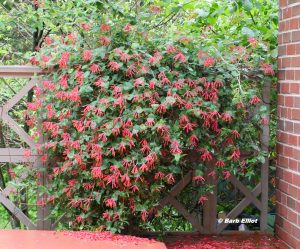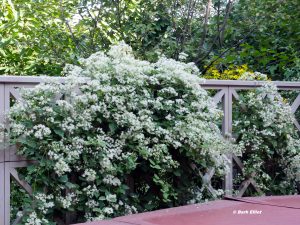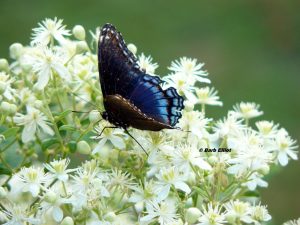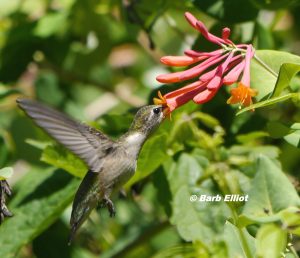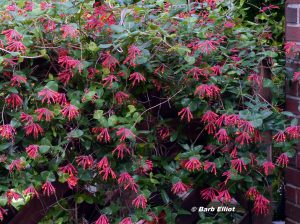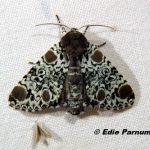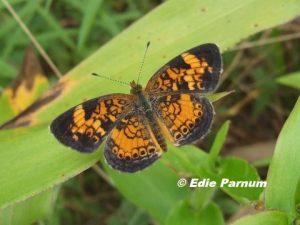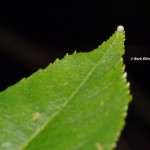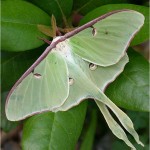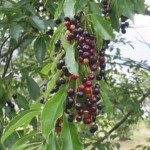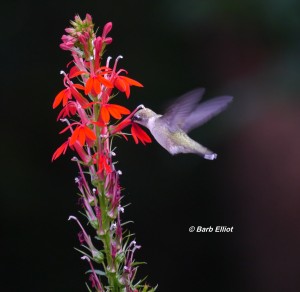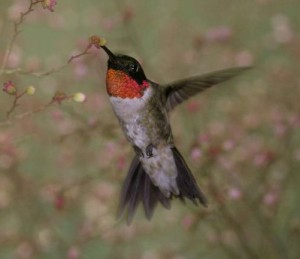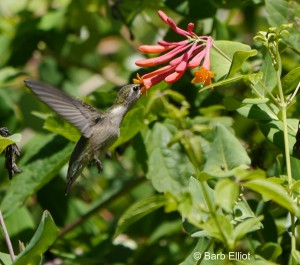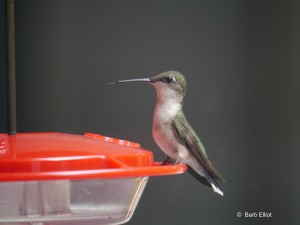By Barb Elliot
Vines have a bad rap. Invasive non-native vines like Kudzu, Oriental Bittersweet, Japanese Honeysuckle, Porcelain Berry, and English Ivy grow up and over trees, often smothering whole forest edges. By making them top-heavy, these vines can damage and pull down entire trees. However, not all vines are bad actors. Most locally native vines are attractive and well-behaved. By providing food, shelter, and nesting places, they add high wildlife value to our habitat gardens. I have three of these natives and I highly value the roles they play in my garden.
Trumpet Honeysuckle, Lonicera sempervirens
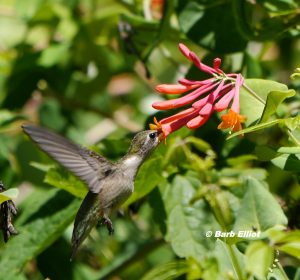
A female Ruby-throated Hummingbird visits Barb’s Trumpet Honeysuckle. © Barb Elliot. Click to enlarge.
With Trumpet (aka Coral) Honeysuckle in your yard, Ruby-throated Hummingbirds will visit – guaranteed! This native honeysuckle is not at all like its unruly cousin, Japanese Honeysuckle. Handsome and well-behaved, this vine sports blue-green foliage and coral-red trumpet-shaped flowers. It’s easy to grow in average, well-drained soils with medium moisture. A twining 10-15’ vine that needs a support, it is striking on a fence or trellis with its profusion of flowers. It grows in shade, but flowers best in full sun. Trumpet Honeysuckle begins blooming in April or May and blooms intermittently through summer and into the fall. In autumn, birds eat the red berries.
Trumpet Honeysuckle provides food, shelter, and nesting locations. One year, American Robins built a nest in one of my honeysuckle vines. A vine growing close to my bird feeders provides shelter for birds escaping hawks and other predators. According to Doug Tallamy, this honeysuckle hosts up to 33 species of butterfly and/or moth caterpillars that eat its leaves. Among them are two day-flying hummingbird look-alike moths. the Hummingbird Clearwing and Snowberry Clearwing.
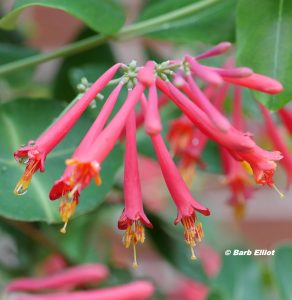
The beautiful trumpet-like flowers of Trumpet Honeysuckle, showing their yellow inner parts. © Barb Elliot. Click to enlarge.
Trumpet Honeysuckle is truly beloved by hummingbirds. I love to sit on my deck and watch these flying jewels sip nectar from the long tubular flowers and even fight over the blossoms. George Washington grew this vine at his Mount Vernon estate where it is still grown today. In a 1785 diary entry, Washington described planting it around columns and along walls. Perhaps he, too, enjoyed the hummingbirds that visited his Trumpet Honeysuckle.
Virginia Creeper, Parthenocissus quinquefolia
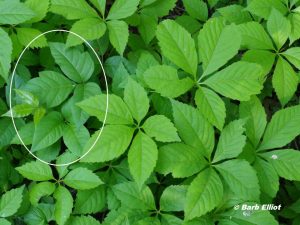
The handsome leaves of Virigina Creeper with their 5 leaflets each. Poison Ivy, circled on left, with its 3 leaflets per leaf. © Barb Elliot. Click to enlarge.
Virginia Creeper, not to be confused with Poison Ivy, is a beneficial vine that’s entirely harmless to humans. To differentiate the two plants, look at the leaves. Poison Ivy always has 3 leaflets per leaf, but Virginia Creeper has 5 leaflets. Some young Virginia Creeper vines may have a few leaves with just 3 leaflets, but most leaves will have 5 leaflets. The green leaves are handsome and in full sun turn bright red or purple in October.

A Virginia Creeper Sphinx moth caterpillar Barb found on her vine. Note the pointed “horn”, or tail, on left hind end – typical of caterpillars in the sphinx moth family. © Barb Elliot. Click to enlarge.
Offering high wildlife value, Virginia Creeper hosts 32 species of caterpillars, including the striking Pandora Sphinx and Abbott’s Sphinx moth caterpillars. These are my most sought after caterpillars, but I have yet to find either of them. However, as a consolation, I’ve discovered several Virginia Creeper Sphinx moth caterpillars, which I raised to become beautiful adult moths.

A Gray Catbird eating Virginia Creeper berries. Note the berries’ red stems. Photo courtesy of and © Adrian Binns/WildlsideNatureTours.com. Click to enlarge.
In spring, the wildlife-friendly Virginia Creeper’s inconspicuous flowers attract bees and other small pollinators. Thirty species of birds, including chickadees, woodpeckers, robins, catbirds, warblers, and bluebirdsrelish the dark blue berries in autumn. Reddish fall foliage and the bright red stems of the berries lure the birds. Small animals use this vine for cover, especially when it grows along the ground. A few years ago, Northern Cardinals built a nest in the Virginia Creeper growing on my arbor.
A deciduous woody vine, Virginia Creeper is easy to grow in full sun to full shade in well-drained soil with average moisture. It will climb brick or stone walls, trellises, arbors, fences, or large trees. One of my favorite ground covers, it will happily cover a stump or wood pile. Although a vigorous grower, climbing 30’ feet or more, it will not smother trees. If it becomes unruly, it can easily be pulled down or cut off at the base where it will re-sprout.
Virgin’s Bower, Clematis virginiana

An Ailanthus Moth visiting Barb’s Virgin’s Bower. These moths visit both during the day and night. © Barb Elliot. Click to enlarge.
Virgin’s Bower, a native clematis, is a superb plant for pollinators. Its small white flowers have a pleasing, sweet fragrance and cover the foliage from mid-to late-August into September. The flowers attract many pollinators, including butterflies, bumble and other native bees, plus interesting wasps and flies. Intent on collecting nectar and pollen from the flowers, they are usually oblivious to my presence.
Predators like spiders and centipedes furtively wait to catchthe unsuspecting pollinators. I have spent hours, both day and night, watching the pollinators and dramas of nature play out on Virgin’s Bower.
Virgin’s Bower is very easy to grow in medium to wet well-drained soil in part shade to full sun. Although I love this vine, it is not for the faint of heart. It is a vigorous grower, and if given support, will climb to 20’. When growing along the ground. it can spread into a tangled
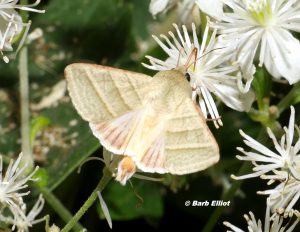
A nighttime visitor to Virgin’s Bower, Tobacco Budworm Heliothis virescen. © Barb Elliot. Click to enlarge.
mass. The vines can take root where they touch the ground. Seeds from its attractive seed heads are windblown, so new plants can pop up elsewhere in your yard. But if you are diligent and keep this vine in check, you and many pollinators will be well-rewarded by your efforts.
Now is a good time to add these vines to your landscape. If you have a small space, Trumpet Honeysuckle will work well. For larger areas, try Virginia Creeper or Virgin’s Bower. These vines will add texture and interest to your landscape. Pollinators, birds and other wildlife will thrive in your garden.
Go here for a list of local native plant retailers who are likely to sell these vines,

